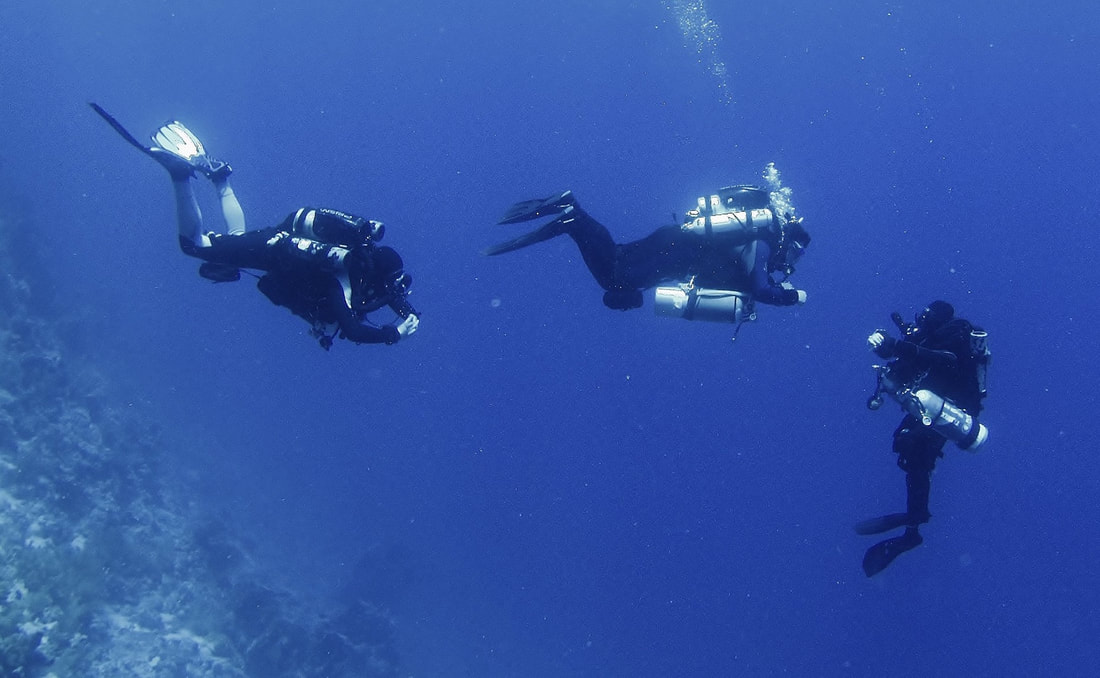"Dad, why do we have two nostrils?"
My colleague received this question from his four-year old. Kids ask the best questions — the kinds of questions that led me to my current work. Some animals gain a directional sense of smell from their two nostrils. That's why dogs can uncover hidden clues for police, find truffles in the woods, and become oddly distracted sniffing things otherwise uninteresting to us. We’re only getting a fraction of the sensory inputs that they are.
As a diver and ocean engineer, I spend a lot of time thinking about how animals perceive a part of the world mostly inaccessible to humans without the aid of technology: the ocean. This vast place that covers most of the Earth’s surface and upon which our life depends is hard for us to comprehend. Its average depth of 3,688 meters is 4x our tallest skyscraper and deeper than any mammal can survive. Most of it is pitch black, and the pressure could crush an army tank. WiFi, GPS, and nearly all the electromagnetic waves we increasingly rely upon do not work, and salt water kills electronics. Yet, many animals manage to thrive in the ocean.
Gordon et al.'s recent paper in Nature Communications reminded me of one of the many biases we have as humans when we’re sensing the world. Whereas dogs rely upon their strong sense of smell, most of us depend heavily on sight to understand the world around us. We ask, "What does that look like?" and "Do you see what I mean?". If I told you about a new place, you would probably want to see photos of it. If I only gave you headphones to listen to its sound, you would probably be frustrated. Yet, most marine animals never know what their environment looks like. They only know how it feels, sounds, or smells. Fish can school tightly because their lateral line sensors detect pressure and flow, detecting minute changes in their environment long before seeing anything. Famously, sharks can detect a drop of blood a mile away.
By avoiding our bias towards human perception, the researchers came up with a novel solution. They demonstrated that broadcasting healthy sounds of a coral reef can lure fish back to a degraded reef and help revive its ecosystem. They are careful to note that this will not reverse the plight of our reefs, and it certainly is not a magic cure for the ocean’s ills, but it is an important tool for reviving reefs that are so essential to the ocean’s health while we work to solve the existential problem of excess carbon that threatens planetary life. It made me wonder what other solutions we are missing when we look at problems from a human-centric perspective. What could we learn if we learned to think less like us, and more like the animals that thrive beneath the waves?
My colleague received this question from his four-year old. Kids ask the best questions — the kinds of questions that led me to my current work. Some animals gain a directional sense of smell from their two nostrils. That's why dogs can uncover hidden clues for police, find truffles in the woods, and become oddly distracted sniffing things otherwise uninteresting to us. We’re only getting a fraction of the sensory inputs that they are.
As a diver and ocean engineer, I spend a lot of time thinking about how animals perceive a part of the world mostly inaccessible to humans without the aid of technology: the ocean. This vast place that covers most of the Earth’s surface and upon which our life depends is hard for us to comprehend. Its average depth of 3,688 meters is 4x our tallest skyscraper and deeper than any mammal can survive. Most of it is pitch black, and the pressure could crush an army tank. WiFi, GPS, and nearly all the electromagnetic waves we increasingly rely upon do not work, and salt water kills electronics. Yet, many animals manage to thrive in the ocean.
Gordon et al.'s recent paper in Nature Communications reminded me of one of the many biases we have as humans when we’re sensing the world. Whereas dogs rely upon their strong sense of smell, most of us depend heavily on sight to understand the world around us. We ask, "What does that look like?" and "Do you see what I mean?". If I told you about a new place, you would probably want to see photos of it. If I only gave you headphones to listen to its sound, you would probably be frustrated. Yet, most marine animals never know what their environment looks like. They only know how it feels, sounds, or smells. Fish can school tightly because their lateral line sensors detect pressure and flow, detecting minute changes in their environment long before seeing anything. Famously, sharks can detect a drop of blood a mile away.
By avoiding our bias towards human perception, the researchers came up with a novel solution. They demonstrated that broadcasting healthy sounds of a coral reef can lure fish back to a degraded reef and help revive its ecosystem. They are careful to note that this will not reverse the plight of our reefs, and it certainly is not a magic cure for the ocean’s ills, but it is an important tool for reviving reefs that are so essential to the ocean’s health while we work to solve the existential problem of excess carbon that threatens planetary life. It made me wonder what other solutions we are missing when we look at problems from a human-centric perspective. What could we learn if we learned to think less like us, and more like the animals that thrive beneath the waves?
Originally published on LinkedIn, shared by X, The Moonshot Factory. It's been reposted on Twitter and Facebook.


 RSS Feed
RSS Feed
